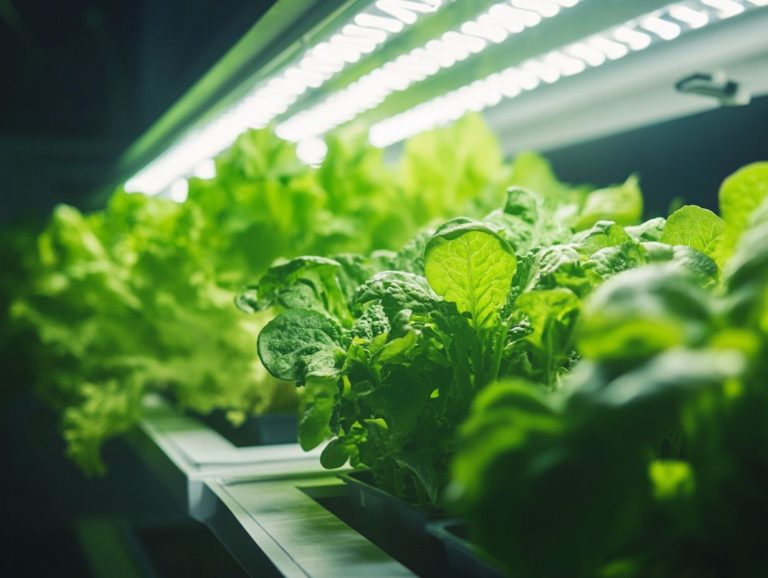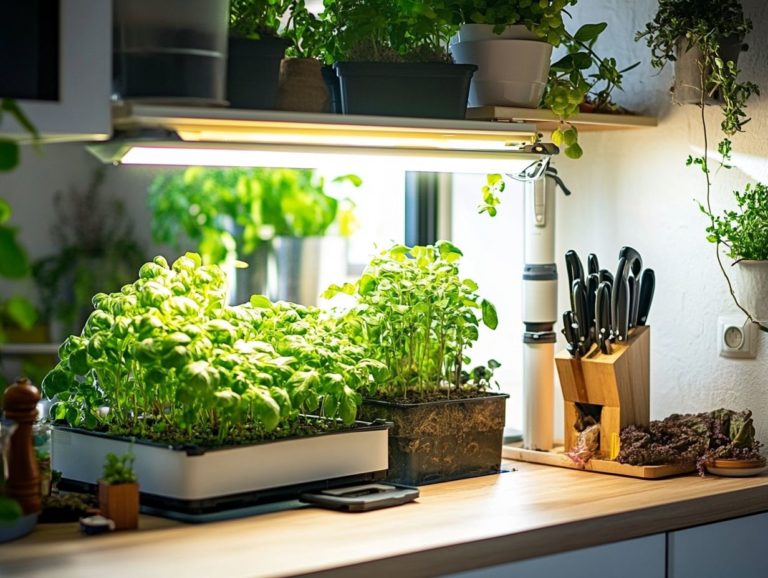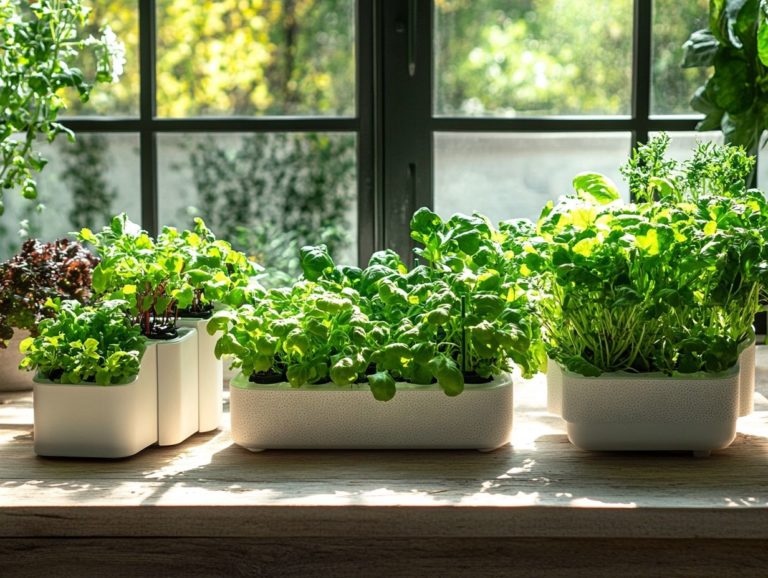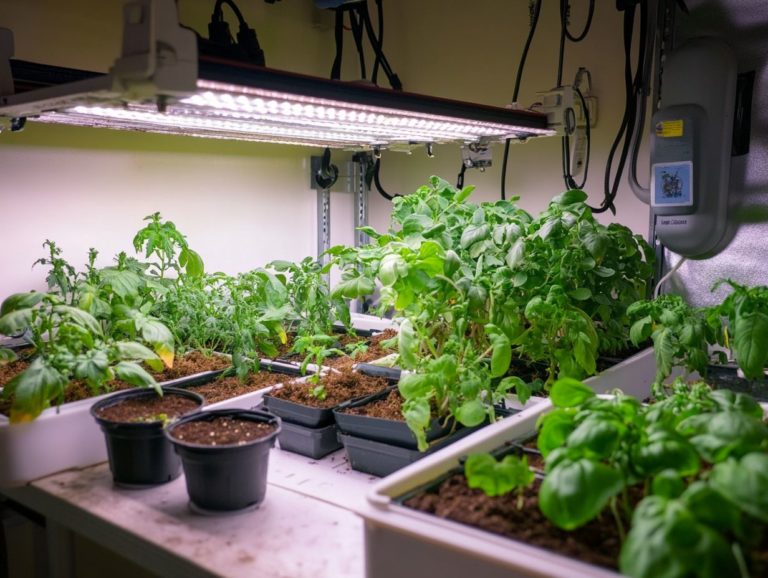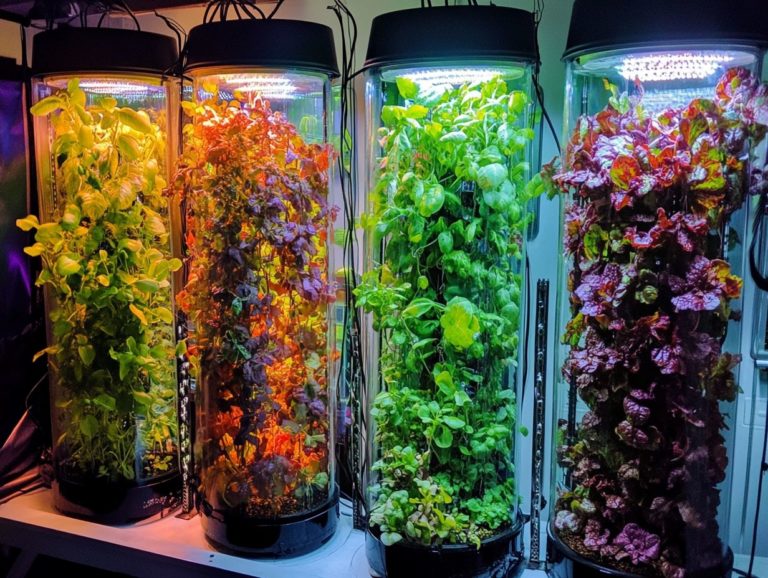5 Hydroponic Systems for Beginners on a Budget
Hydroponics presents a cutting-edge method for cultivating plants without the need for soil, making it an enticing choice for both novices and experienced gardeners alike.
Explore five accessible hydroponic systems that are ideal for those mindful of their budget. Ranging from Deep Water Culture to Nutrient Film Technique, each method boasts its own distinct advantages and requirements, allowing you to find the perfect fit for your needs.
You will also learn about essential components, common pitfalls to sidestep, and budget-friendly maintenance tips to ensure your success as you embark on your hydroponic journey.
Contents
- Key Takeaways:
- 1. Deep Water Culture (DWC)
- 2. Ebb and Flow (Flood and Drain)
- 3. Drip System
- 4. Wick System
- 5. Nutrient Film Technique (NFT)
- What Is Hydroponics and How Does It Work?
- Frequently Asked Questions
- What are 5 hydroponic systems for beginners on a budget?
- Which hydroponic system is the most cost-effective for beginners?
- What are the benefits of using hydroponic systems?
- Do hydroponic systems require a lot of maintenance?
- Can I use any type of plant in a hydroponic system?
- Are there any drawbacks to using hydroponic systems?
Key Takeaways:
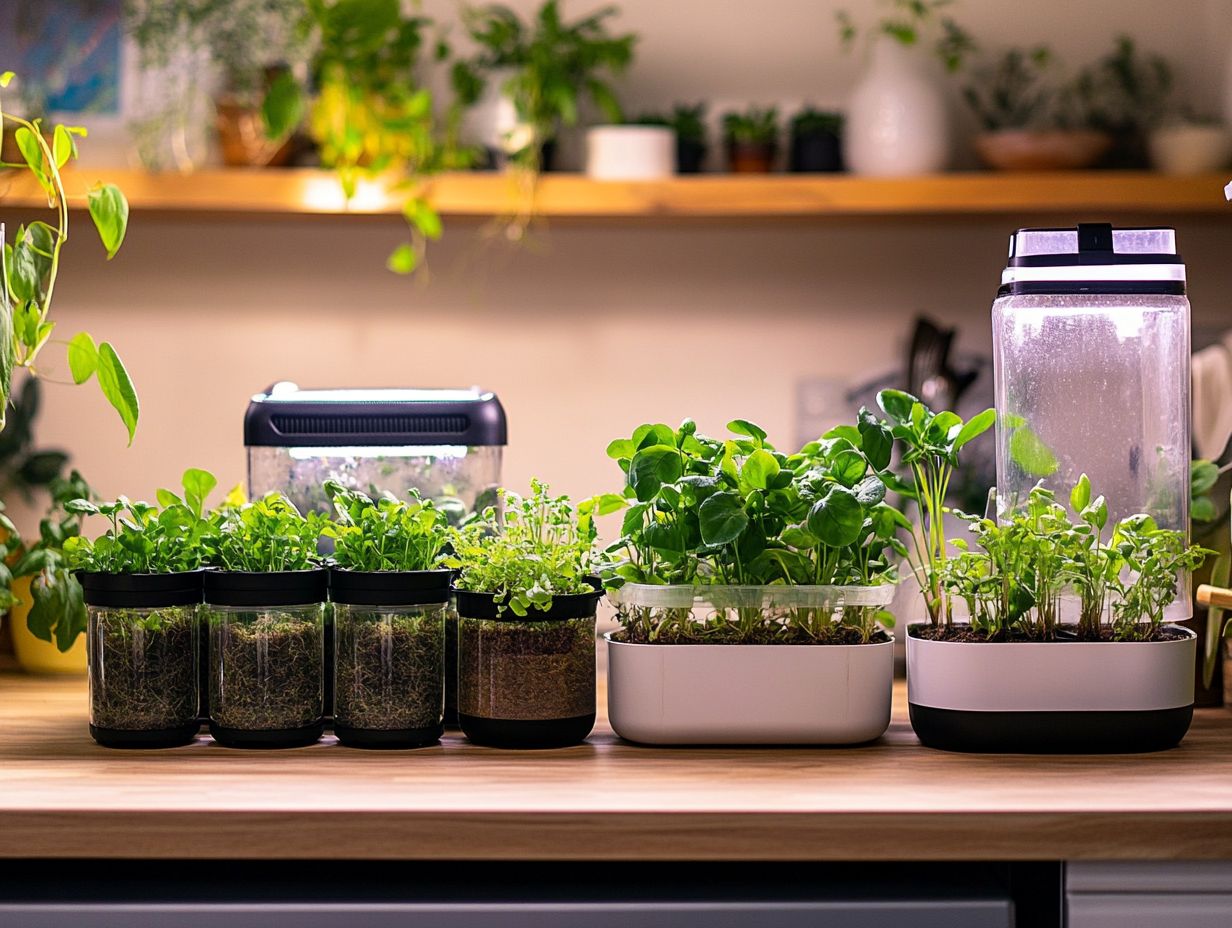
- Save money and grow your own produce with hydroponics!
- Choose from 5 budget-friendly systems like DWC, Ebb and Flow, Drip, Wick, and NFT.
- Keep plants thriving with proper components, setup, and maintenance.
1. Deep Water Culture (DWC)
Deep Water Culture (DWC) is a game-changer in the world of hydroponics. It allows you to cultivate plants in water full of nutrients that promotes optimal growth. Whether you re a novice or a seasoned indoor gardener, this method can help you maximize your yields with ease.
The secret lies in a well-designed water circulation system that guarantees adequate oxygenation and nutrient delivery key ingredients for thriving indoor plants like lettuce and herbs.
Unlike traditional gardening, where the whims of soil quality and weather can dictate your success, DWC gives you the power with consistent control over growing conditions. This means faster growth rates and higher yields are well within your reach.
Plus, this hydroponic approach liberates you from the pests and diseases often associated with soil-based gardening, all while saving precious space ideal for urban settings.
When you stack DWC up against other hydroponic systems, its simplicity and low operational costs really shine. By focusing on fast-growing varieties like leafy greens and aromatic herbs, you can achieve impressive growth in no time.
Just remember to regularly monitor water quality, pH levels (which measures how acidic or alkaline a solution is), and nutrient solutions to ensure your plants are receiving the perfect balance for thriving. This enhances the many benefits of this effective gardening technique.
2. Ebb and Flow (Flood and Drain)
The Ebb and Flow system, often referred to as Flood and Drain, is an incredibly versatile hydroponic setup. It periodically inundates your plant roots with nutrient-rich water before draining it away. Your plants will thrive with the perfect mix of hydration and oxygen!
This method enhances water efficiency and is particularly advantageous in urban gardening, where space and resources may be limited. By mimicking natural wet and dry cycles, this system fosters strong root growth, resulting in healthier plants.
Leafy greens such as lettuce and herbs like basil are ideal candidates for this technique, thriving in a well-aerated environment. As you set up a reliable water reservoir, it s essential to ensure that the pump mechanisms operate consistently and maintain the right nutrient balance.
Regularly monitoring the nutrient solution s pH and electrical conductivity will maximize your plants’ health and yield, ensuring a thriving garden.
3. Drip System
The Drip System stands out as a top choice for indoor gardeners. It employs a sophisticated network of tubing and emitters to deliver a slow, steady stream of nutrient solution straight to your plants’ roots.
This method ensures efficient water usage and promotes healthy growth while minimizing waste. Easily integrated into various hydroponic kits, it’s particularly effective for a wide range of crops, from vibrant greens to fragrant herbs.
Within this system, components like timers and pressure regulators are essential for maintaining optimal flow rates and timing to boost overall efficiency. Choosing the right emitters is crucial, as each plant has its unique water requirements that need to be addressed for successful cultivation.
The adaptability of the drip system allows you to tailor your setup, whether you’re nurturing delicate microgreens or hearty herbs. Its user-friendly design gives you the power to experiment with an array of plant varieties, making it a fantastic option for anyone eager to broaden their gardening horizons.
Start your hydroponic adventure today for fresher produce at home!
4. Wick System
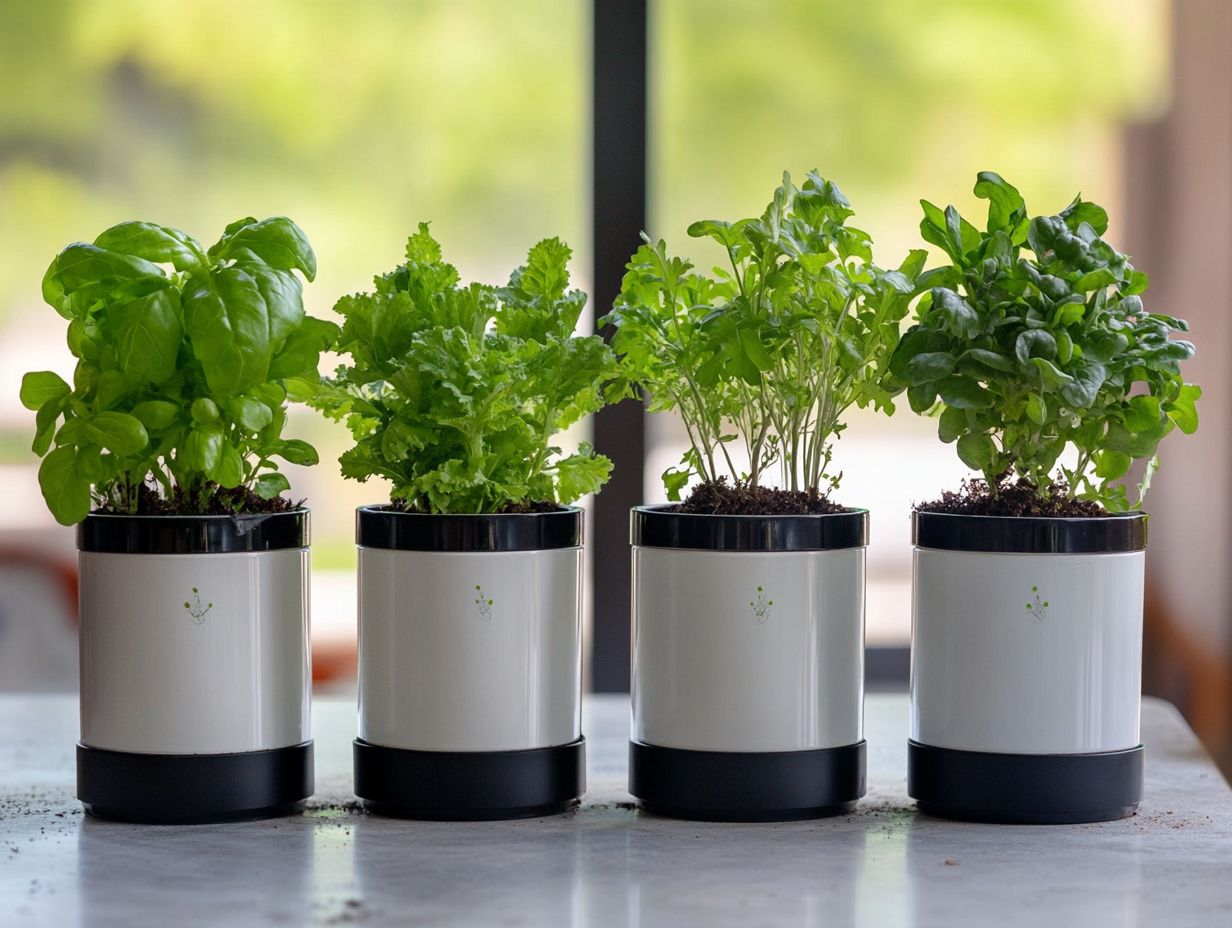
The Wick System is a simple and user-friendly hydroponic method that uses capillary action, which is how water moves up through materials, to draw nutrient-rich water directly to plant roots. This makes it an excellent choice for indoor gardening, allowing you to grow a variety of herbs and microgreens without a complicated setup.
This method uses basic materials like cotton or nylon wicks that absorb water and nutrients from a reservoir, delivering a steady supply to your plants. Its minimal requirements make the Wick System particularly effective for growing plants such as basil, mint, and lettuce, which thrive in consistently moist conditions.
Selecting the right materials is essential. Quality potting media and suitable containers can significantly improve the system’s efficiency. Incorporating liquid plant food helps ensure your plants receive the nutrients they need, promoting optimal growth and health.
This system is a fantastic choice for anyone eager to boost their indoor gardening game!
5. Nutrient Film Technique (NFT)
Nutrient Film Technique (NFT) is a modern hydroponic system that allows a thin film of nutrient solution to flow continuously over your plants’ roots. This method provides essential nutrients and oxygen while using minimal water, making it a sustainable option for urban gardening or vertical hydroponics.
With NFT, you can enjoy faster growth rates compared to traditional soil systems, which often require more space and resources. This technique is particularly effective for growing leafy greens and herbs, as these plants thrive in nutrient-rich environments with plenty of oxygen.
Maintaining optimal conditions, such as a well-balanced pH level and nutrient solution, is crucial for plant health. Monitoring these factors lets you adjust for optimal growth, ensuring your plants achieve their maximum yield and quality.
What Is Hydroponics and How Does It Work?
Hydroponics offers a modern approach to growing plants without soil. By using nutrient-rich water solutions, you can deliver essential nutrients directly to the roots, leading to faster growth and higher yields. This method is quickly becoming the go-to choice for urban gardening enthusiasts and those focused on sustainability.
This innovative technique opens up possibilities for cultivating a variety of crops, from leafy greens to vibrant vegetables, all while conserving precious resources. Hydroponic systems come in several forms, such as deep water culture, nutrient film technique, and aeroponics, each providing unique ways to optimize plant health and productivity. For beginners looking to explore this method, the top 5 hydroponic growing systems can offer valuable insights.
Unlike traditional soil gardening, which can hinder root development and harbor pathogens, hydroponics allows you to control nutrient delivery, pH, and moisture levels precisely. This means you can create optimal growth conditions year-round.
Hydroponics is not just efficient; it s also an environmentally friendly alternative that reduces water usage while maximizing crop yields in limited spaces. Start exploring hydroponics today to transform your gardening experience!
What Are the Benefits of Using Hydroponic Systems?
Hydroponic systems provide numerous advantages that can improve your gardening experience. They increase plant growth efficiency while reducing water usage.
You can grow a wider variety of crops in smaller spaces. This method enhances both urban and home gardening effectiveness.
These systems promote faster plant growth, helping them reach maturity quickly compared to traditional soil methods. Hydroponic setups often yield impressively higher harvests, making them attractive for anyone looking to maximize their crops.
Pest issues are significantly reduced in controlled environments. This means you ll need fewer pesticides and can cultivate organic microgreens and herbs year-round.
What Are the Key Components of a Hydroponic System?
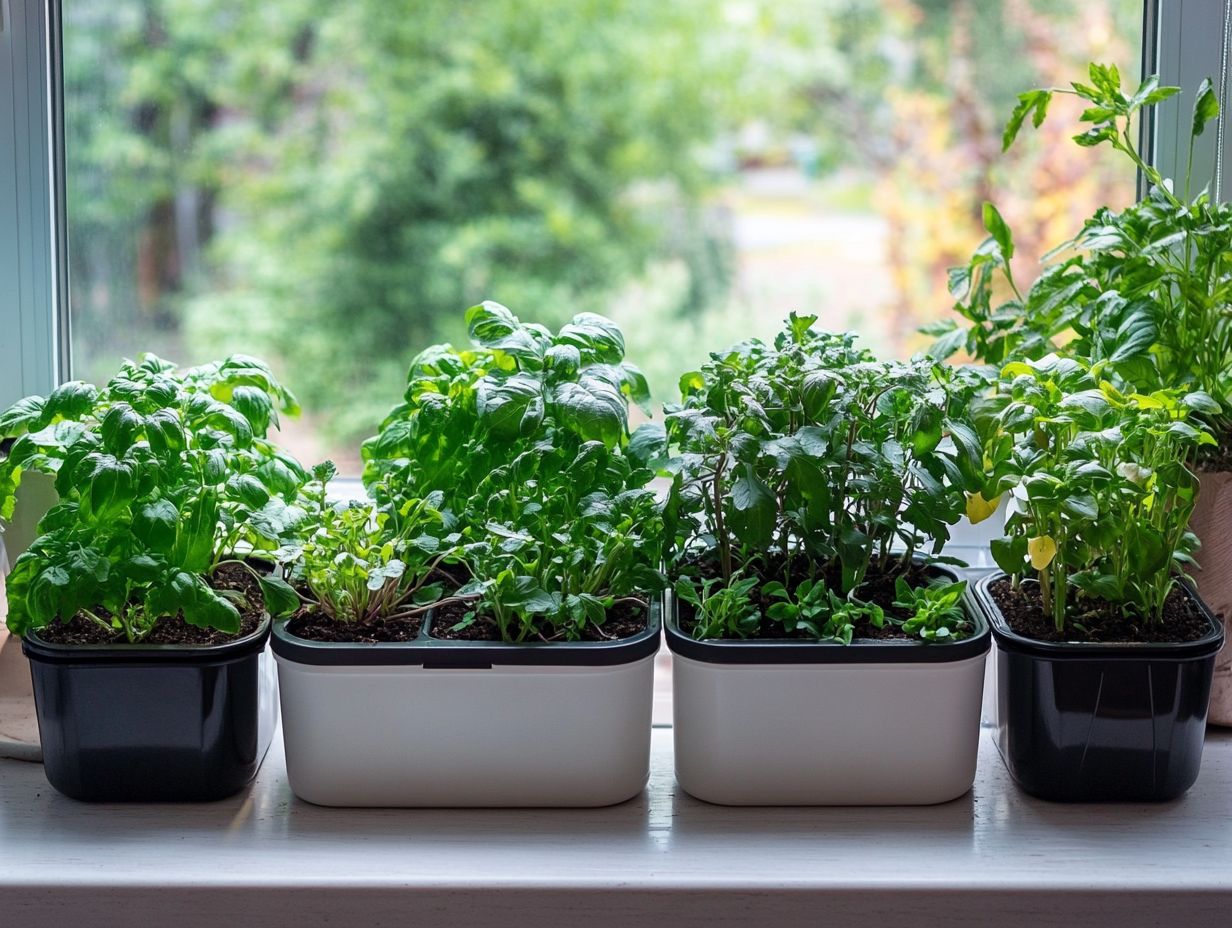
A hydroponic system consists of a water reservoir, nutrient solutions, grow lights, and suitable growing mediums. Each component works together to nourish your plants.
The water reservoir is crucial for delivering essential nutrients. It’s important to monitor pH levels for optimal nutrient absorption.
Choosing the right growing medium, like rock wool or coconut coir, affects root air flow and moisture retention. Grow lights are vital for simulating natural sunlight, allowing plants to photosynthesize effectively.
Using air pumps and timers can boost oxygen levels and automate nutrient delivery, enhancing plant health.
How to Choose the Right Hydroponic System for Your Needs?
To choose the right hydroponic system, consider your available space, plant types, and gardening experience. Select a user-friendly setup that fits your lifestyle.
Each plant species has unique needs. Some prefer nutrient-rich water, while others thrive under certain lighting.
If space is limited, look into compact systems like the AeroGarden Bounty. This efficient option allows you to grow various herbs and vegetables indoors without feeling cramped.
The Lettuce Grow Farmstand supports higher yields and adapts easily to your gardening goals. It simplifies the process for everyone, from beginners to seasoned growers.
By aligning your hydroponic system choice with your preferences, you’ll set the foundation for a rewarding gardening journey.
What Are the Common Mistakes to Avoid When Setting Up a Hydroponic System?
When setting up a hydroponic system, avoid common mistakes that can harm plant growth. Pay attention to pH levels, nutrient solutions, and lighting for gardening success.
Beginners often miscalculate nutrient concentrations. This can lead to deficiencies or toxicities that harm plant health.
For example, over-fertilizing can cause root burn. Skimping on nutrients can stunt growth.
Neglecting environmental factors, like temperature and humidity, creates an inhospitable atmosphere for your plants. Regularly monitor and adjust pH and nutrient levels.
Stick to a reliable feeding schedule. Using environmental controls, like fans or heaters, enhances growing conditions.
What Are Some Tips for Maintaining a Hydroponic System on a Budget?
You can maintain a hydroponic system on a budget with the right strategies. Consider DIY techniques, reusing materials, and sourcing low-cost nutrients.
Utilizing liquid plant food is a cost-effective option. Local community garden resources might offer affordable or free supplies.
Join online forums for DIY hacks shared by experienced enthusiasts. This can provide valuable insights into cost-saving methods.
Regularly checking nutrient levels and pH prevents imbalances that can harm plant vitality. Repurposing containers and using low-cost LED lights keeps initial costs down.
A commitment to routine checks reduces waste and boosts growth efficiency. This lets you cultivate a flourishing garden without overspending.
Frequently Asked Questions
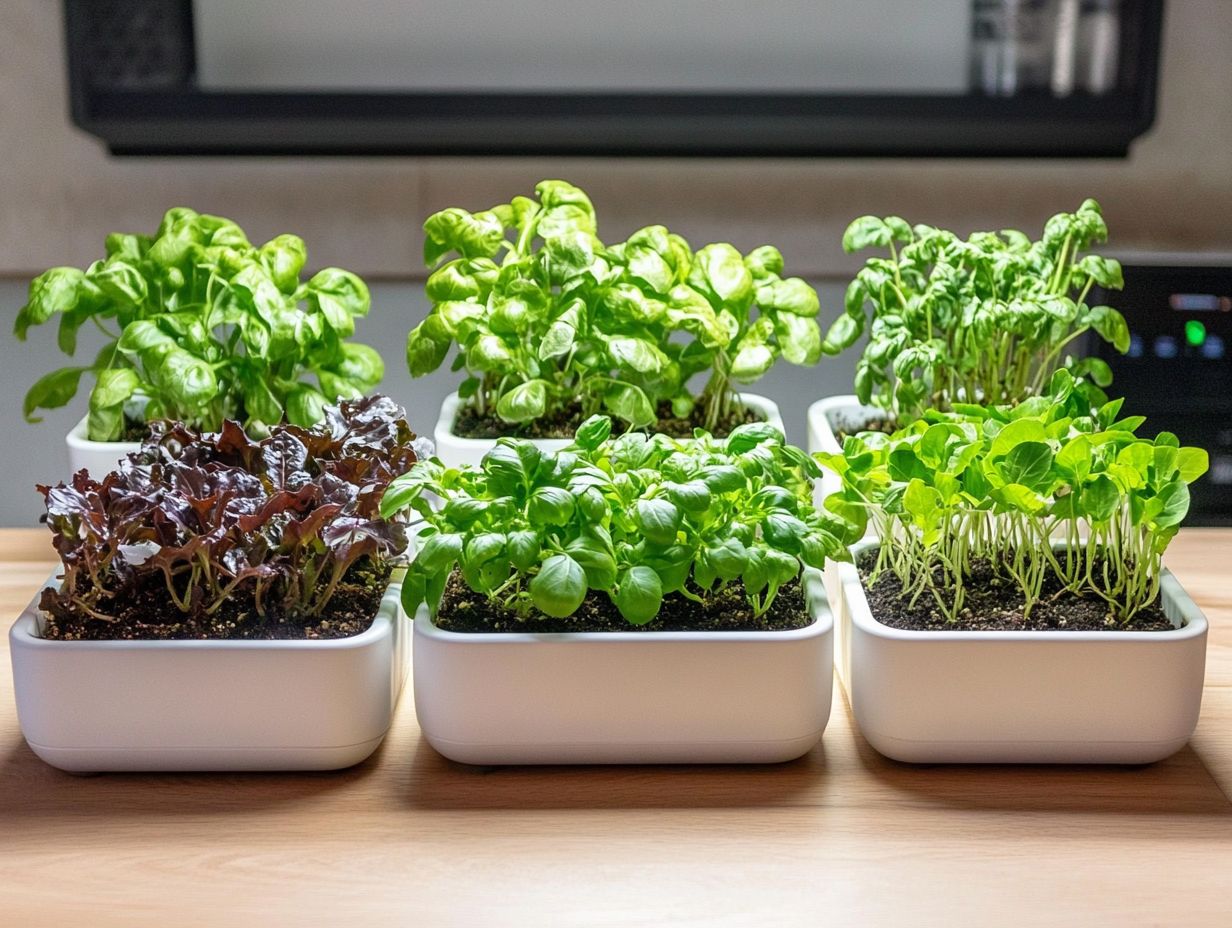
What are 5 hydroponic systems for beginners on a budget?
1. Deep Water Culture (DWC) uses a container with nutrient-rich water and an air pump for oxygen.
2. Ebb and Flow (Flood and Drain) sends nutrient solution to the growing tray from a reservoir.
3. Drip System delivers nutrients slowly to the roots.
4. Aeroponics mist roots with nutrients while they are suspended in air.
5. Wick System is the simplest and uses a wick to transfer nutrients to the roots.
Which hydroponic system is the most cost-effective for beginners?
The Wick System is the most cost-effective for beginners on a budget. It requires minimal materials and can be easily set up at home with items from around the house.
What are the benefits of using hydroponic systems?
Hydroponic systems offer several benefits such as faster plant growth, higher yields, and the ability to grow plants in smaller spaces. They also use less water and are less prone to pests and diseases compared to traditional soil gardening.
Do hydroponic systems require a lot of maintenance?
No, hydroponic systems do not require a lot of maintenance. However, regular monitoring of the nutrient solution levels and pH balance is necessary, as well as occasional cleaning and changing of the solution.
Can I use any type of plant in a hydroponic system?
Most plants can thrive in hydroponic systems, but some may require specific nutrients or growing conditions. It is best to research the specific needs of the plants you want to grow before choosing a hydroponic system.
Are there any drawbacks to using hydroponic systems?
The initial setup cost of a hydroponic system may be higher compared to traditional soil gardening. There is also a learning curve for beginners to understand and maintain the system properly. Additionally, power outages or equipment failures can be detrimental to the plants if not resolved quickly.


